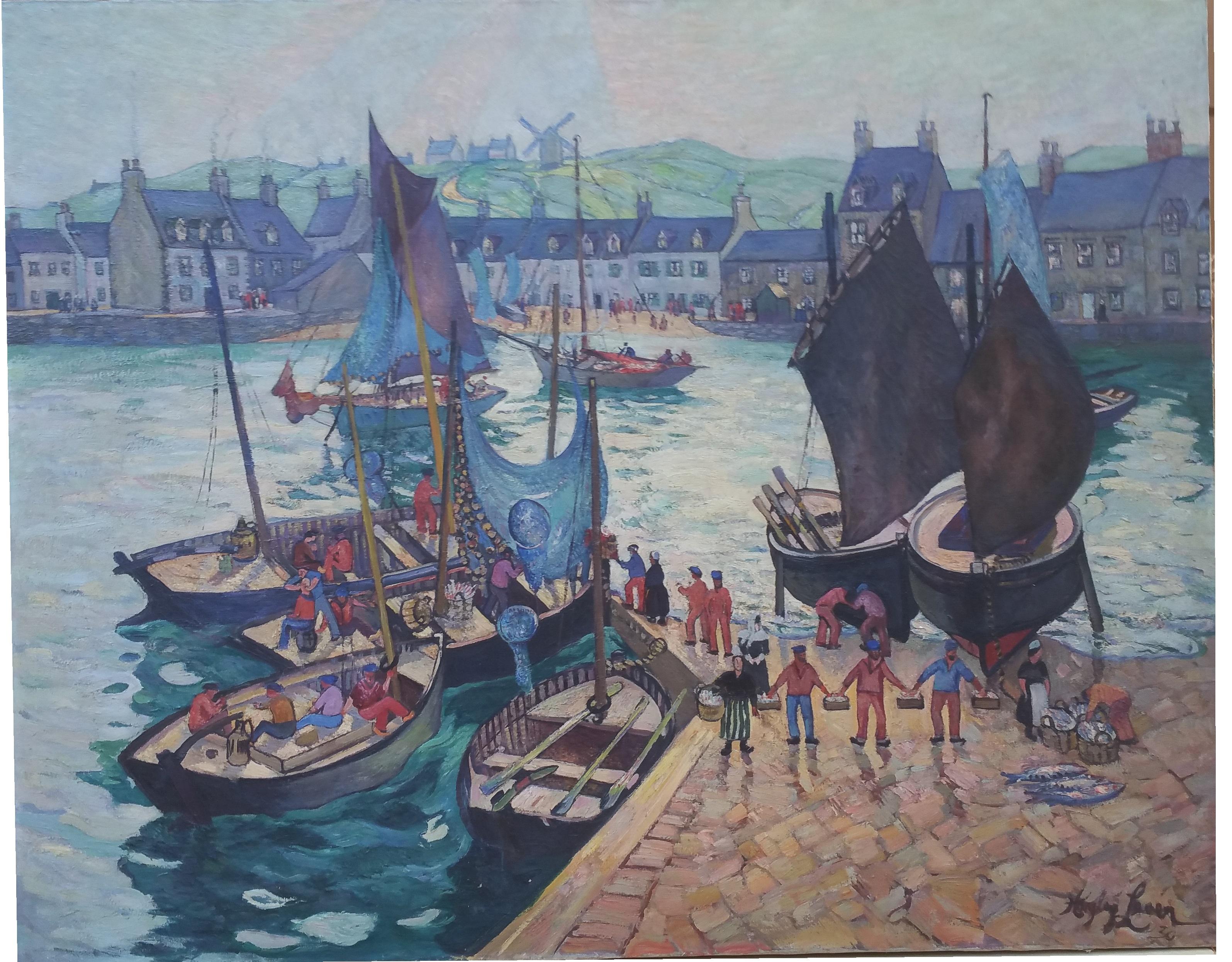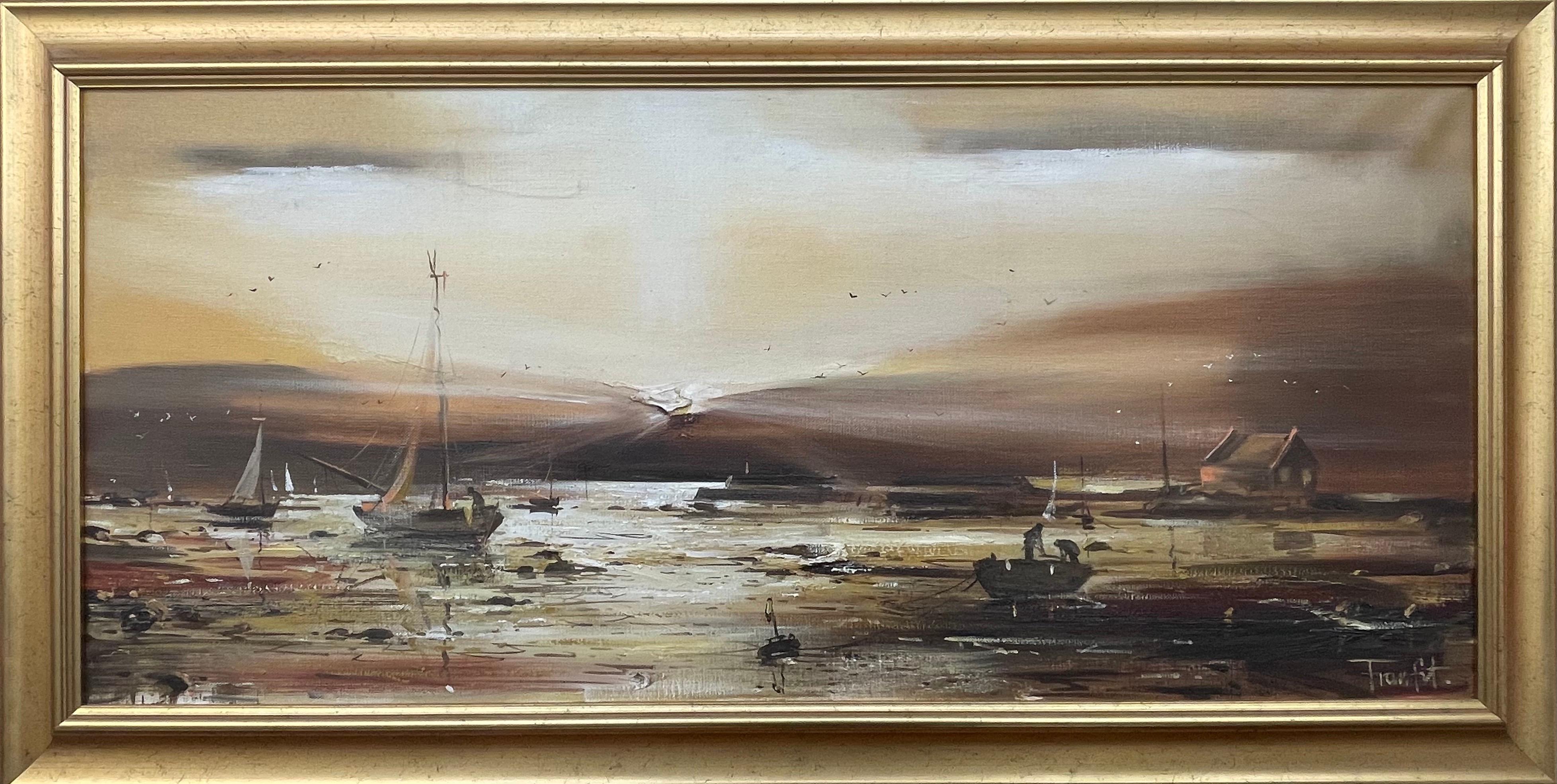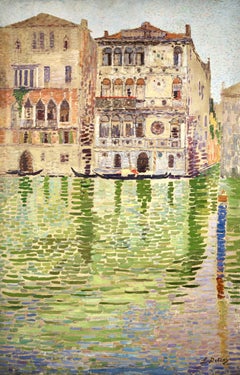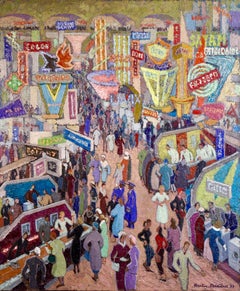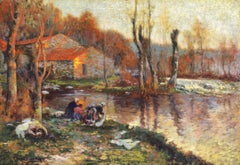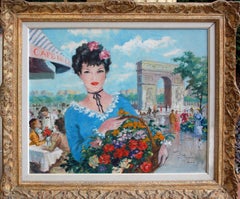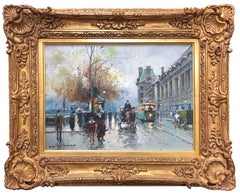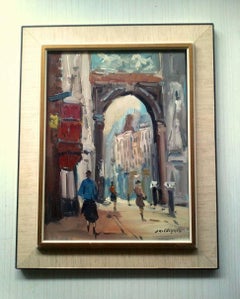Items Similar to Le Pont de Charenton - Post Impressionist Landscape Oil by Nathan Grunsweigh
Want more images or videos?
Request additional images or videos from the seller
1 of 17
Nathan GrunsweighLe Pont de Charenton - Post Impressionist Landscape Oil by Nathan Grunsweighc.1920
c.1920
About the Item
Signed post impressionist oil on canvas riverscape circa 1920 but Polish painter Nathan Grunsweigh. The work depicts a view of the bridge over the River Seine in Paris. A beautifully coloured piece.
Signature:
Signed lower left
Dimensions:
Framed: 28"x21"
Unframed: 11"x14"
Provenance:
The collection of Daniel & Rose Grunsweigh
Nathan GRUNZWEIG (spelling of his birth name) was born in Krakow on April 2, 1880, to an accountant father. Shortly after his birth, the family moved to Wolanka, in the Drohobych district of present-day Ukraine, probably to find better income there, as development related to oil drilling attracted a mosaic of nationalities. But new legislation granting oil exploration only to landowners drove out the small operators.
The family returned to Krakow and then moved to Antwerp in 1893, where Nathan's father was registered as a diamond merchant. Thirteen-year-old Nathan enrolled in drawing and painting classes at the Royal Academy of Fine Arts in Antwerp and exhibited in 1908 at the Maison de Sion. But it is likely that he organized his first exhibition in Brussels in 1906, according to the mention he made on the reverse of a painting by spelling his name Grunsweigh.
And then, in 1908, it was Paris, a beacon of artists who flocked from all over the world. His two children, David and Adéline (Rébecca), were born there in 1912 and 1913, after his marriage to Fanny Edinger, originally from Alsace. The family probably spent the period of the First World War in Amsterdam, where their youngest son, Daniel, was born in 1914. Very few paintings from this period have survived. They show the painter's inclination for artistic experimentation and his mastery of different currents.The family returned to Paris in the 1920s and settled in the inner suburbs, in the pretty town of Vésinet.
Maurice Utrillo, who revived the art of landscape as a new modernity, captivated Grunsweigh with his views of Montmartre.
The latter began to travel through Paris and its suburbs , planting his easel to sketch the streets, crossroads, squares, boulevards.
In 1924, the new Pierre gallery run by Pierre Loeb (who would become one of the great promoters of surrealism), hosted a personal exhibition Grunsweigh, in collaboration with the poet Gustave Kahn, whom Grunsweigh admired, just after the inaugural one by Jules Pascin. There were landscapes and still lifes with precise, firm, linear outlines, in the vein of Utrillo, all hailed by critics, as by Gustave Kahn in the preface to the catalog, or by Florent Fels: "His works, beautiful and nuanced, depict suburban streets, the little gardens of the Parisian suburbs, and landscapes where town and country seem to be vying for supremacy. This is where he lives, in a small house, in a sad street. In the morning, people go to work in Paris and the streets empty. In the evening the silhouettes return by train, and so on. There is no joy here. Yet Grunsweigh is a conscientious and simple man and sometimes, a flash of gray , a charming silvery gray shimmers in its melancholy images, like the glow of a pearl".
Hailed by critics as a landscape painter, he exhibited in 1925 at the Galerie de la Maison Blanc, alongside Utrillo and other landscape painters. He even exhibited at the Salon des Indépendants in 1926 a painting treated in the style of Naïve art, which he entitled Le paysagiste, which represents an artist (probably a self-portrait), oversized, painting in a street, under the gaze of passers-by.
Gustave Kahn loves his still lifes. In 1925, he wrote in Le Mercure de France: "... they are curious, composed with the greatest precision, almost in a straight line, animated by a charming color". The firmness of the contours, the colors used reveal a subtle influence of the art of Paul Cézanne. There are a number of cubist motifs reinterpreted by the artist, such as a typographic element or the use of multiple perspectives within a frame to make the painted space unreal. The flat plane of a table spans the entire.
- Creator:Nathan Grunsweigh (1880 - 1956, Polish)
- Creation Year:c.1920
- Dimensions:Height: 28 in (71.12 cm)Width: 21 in (53.34 cm)
- Medium:
- Movement & Style:
- Period:
- Condition:Unrestored original condition - some light surface crazing.
- Gallery Location:Marlow, GB
- Reference Number:Seller: LFA03761stDibs: LU415310089312
About the Seller
5.0
Gold Seller
These expertly vetted sellers are highly rated and consistently exceed customer expectations.
Established in 2001
1stDibs seller since 2016
687 sales on 1stDibs
Typical response time: 2 hours
- ShippingRetrieving quote...Ships From: Marlow, United Kingdom
- Return PolicyA return for this item may be initiated within 3 days of delivery.
Authenticity Guarantee
In the unlikely event there’s an issue with an item’s authenticity, contact us within 1 year for a full refund. DetailsMoney-Back Guarantee
If your item is not as described, is damaged in transit, or does not arrive, contact us within 7 days for a full refund. Details24-Hour Cancellation
You have a 24-hour grace period in which to reconsider your purchase, with no questions asked.Vetted Professional Sellers
Our world-class sellers must adhere to strict standards for service and quality, maintaining the integrity of our listings.Price-Match Guarantee
If you find that a seller listed the same item for a lower price elsewhere, we’ll match it.Trusted Global Delivery
Our best-in-class carrier network provides specialized shipping options worldwide, including custom delivery.More From This Seller
View AllVenice - Post Impressionist Venetian Landscape Oil Painting by Leon Detroy
By Leon Detroy
Located in Marlow, Buckinghamshire
Signed landscape oil on canvas circa 1910 by French post impressionist painter Leon Detroy. This work is painted in a divisionist style and depicts a view of gondolas on the canal in...
Category
Early 20th Century Post-Impressionist Landscape Paintings
Materials
Canvas, Oil
Figures at Household Arts Show - Post Impressionist Oil by J Martin-Ferrieres
By Jacques Martin-Ferrières
Located in Marlow, Buckinghamshire
A wonderful pointillist oil on canvas by French post-impressionist painter Jacques Martin-Ferrieres. The piece depicts people visiting a bustling fair - Salon des arts ménagers (Hous...
Category
1950s Post-Impressionist Figurative Paintings
Materials
Canvas, Oil
La Colline Saint Catherine - Post Impressionist Landscape Oil by Robert Pinchon
By Robert Antoine Pinchon
Located in Marlow, Buckinghamshire
Signed fauvist oil on canvas riverscape c.1908 by French post impressionist painter Robert Antoine Pinchon. The work depicts a view of the River Seine in Rouen, with Saint Catherine'...
Category
Early 1900s Post-Impressionist Landscape Paintings
Materials
Oil, Canvas
Les Lavandieres - Post Impressionist Landscape Oil Painting - Michel Korochansky
By Michel Korochansky
Located in Marlow, Buckinghamshire
Signed oil on canvas circa 1910 by French post impressionist painter Michel Korochansky. This autumnal landscape depicts a view of women washing linen on the bank of a river. The las...
Category
1910s Post-Impressionist Landscape Paintings
Materials
Canvas, Oil
Loading Flax on the Barges - Post Impressionist Landscape Oil by Modest Huys
Located in Marlow, Buckinghamshire
Signed divisionist landscape oil on canvas by Belgian post impressionist painter Modest Huys. This stunning piece depicts workers on the bank of a river loading flax onto barges.
Signature:
Signed lower right
Dimensions:
Framed: 23"x27"
Unframed: 15"x19"
Provenance:
Private collection - Belgium
Modest Huys (25 October 1874, in Zulte – 30 January 1932, in Zulte) was a Flemish impressionist and luminist painter, who is regarded as one of the greatest Belgian painters of the 20th century.
From a young age, Modest Huys worked in his father's painting and decorating business and later studied at the "Gentse Nijverheidschool" (Ghent Industrial School). In 1891 or 1892, he came into contact with Emile Claus, who encouraged his artistic inclinations. In 1900, he enrolled at the Royal Academy of Fine Arts where his teachers were Eugène Joors and Frans Van Leemputten but he never completed his studies. It was about this time that he became lifelong friends with the author Stijn Streuvels.
In 1902, he debuted at the Sint-Lucasgilde in Kortrijk and began to exhibit more widely. He spent time in Meetjesland, painting landscapes. From 1905, he participated in the exhibitions of Vie et Lumière...
Category
Early 1900s Post-Impressionist Landscape Paintings
Materials
Oil, Canvas
Church Gardens - French Post Impressionist Oil, Landscape by Victor Charreton
By Victor Charreton
Located in Marlow, Buckinghamshire
Stunning signed landscape oil on canvas circa 1910 by sought after French post impressionist painter Victor Charreton. A wonderful and colourful depiction of a green church garden la...
Category
1910s Post-Impressionist Landscape Paintings
Materials
Oil, Canvas
You May Also Like
Le Panier de Fleurs, L'Arc de Triomphe
By Francois Gerome
Located in Missouri, MO
Francois Gerome (b. 1895)
"Le Panier de Fleurs, L'Arc de Triomphe" c. 1950
Oil on Canvas
Signed "F. Gerome" Lower Right
Canvas Size: 20 x 24 inches
Framed Size: approx. 26 1/2 x 30 ...
Category
Mid-20th Century Post-Impressionist Figurative Paintings
Materials
Oil, Canvas
Price Upon Request
Quai de Louvre
By Antoine Blanchard
Located in Missouri, MO
Antoine Blanchard
"Quai de Louvre"
Oil on Canvas
Signed
Canvas Size: approx 13 x 18
Framed Size: approx. 22 x 26
Category
Mid-20th Century Post-Impressionist Landscape Paintings
Materials
Oil, Canvas
Price Upon Request
Fishing Harbor, Brittiny
By Hayley Lever
Located in Saratoga Springs, NY
Signed lower right and dated 1930.
Lever’s “Fishing Harbor in Brittany” is as much a scene celebrating the boats and quaint architecture of coastal France, as it is a nod to its ...
Category
1930s Post-Impressionist Figurative Paintings
Materials
Canvas, Oil
Price Upon Request
The Libertine Girls of Rue Saint Denis
By Jan Kelderman
Located in Paris, FR
Charming Dutch 1950's oil on canvas painting signed by J. KELDERMAN
In a very good general condition .
It représents the libertine courtesan working ...
Category
20th Century Post-Impressionist Figurative Paintings
Materials
Oil, Canvas
Golden Brown Ireland Seascape Landscape at Dusk by Contemporary Irish Artist
Located in Preston, GB
Golden Brown Ireland Seascape Landscape at Dusk by Contemporary Irish Artist, Frank Fitzsimons
Art measures 36 x 16 inches
Frame measure 41 x 21 inc...
Category
1980s Post-Impressionist Landscape Paintings
Materials
Canvas, Oil
"Boulevard of Paris", 20th Century oil on canvas by Spanish artist E. Grau Sala
By Emilio Grau Sala
Located in Madrid, ES
EMILIO GRAU SALA
Spanish, 1911 - 1975
BOULEVARD OF PARIS
signed Grau Sala (lower right)
oil on canvas
25-1/2 X 32 inches (65 X 81 cm.)
framed: 36-1/4 X 42-1/2 inches (92 X 108 cm.)
PROVENANCE
Sale: Sotheby´s Olympia London, 20 October 2006
Emilio Grau Sala came from a family of artists. He was born in Barcelona in 1911 and his father, a good cartoonist, had been one of the promoters of the "Salon des Humanistes" and made his exhibitions normally in the Parés Hall.
His first works were exhibited at the Salon des Independents, in the years 1930-33.
Grau Sala was essentially a Mediterranean painter, son of post-impressionism and enriched with French painting of the last fifty years.
In this work Grau Sala has a loose, subtle brushstroke, in which the color shapes the entire work. The bright and transparent whites that give life to young schoolgirls contrast with the brushstrokes of blacks from the nun who accompanies them. The explosion of greens is refreshing, it surrounds us and transports us to an idyllic place, even if it is a citizen boulevard, which becomes friendly and beautiful.
His works can be found in the Museums of the Villa de Paris, L'Ile de France Museum, at the Château de Sceaux, Honfleur Museum, La Rochelle Museum, Barcelona Museum, Tossa de Mar...
Category
1950s Post-Impressionist Landscape Paintings
Materials
Oil, Canvas
Recently Viewed
View AllMore Ways To Browse
1920 Train
Naive Landscape
Naive Landscape Painting
Cubist Oil Landscape
Oil Painting Cubist Landscape
Pont Des Art
Small Garden Oil Landscape Paintings
Pont Des Art Paris
Antique Silhouette Frames
Antique Framed Silhouettes
Polish Impressionist
Pont Des Arts
River Of No Return
Antique Silhouette Paintings
Les Boulevards
Alsace Art
French Impressionist Oil Painting Pierre
Impressionist Garden With People


